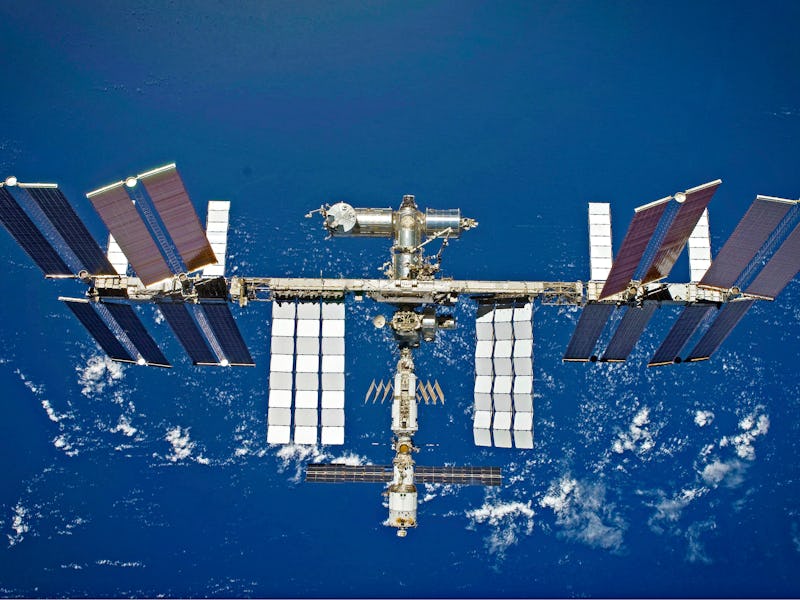After the ISS Comes the Cis-Lunar Land Rush
What happens when low Earth orbit gets privatized? Depends on who you ask.

The International Space Station has played host to human beings for the past 15 years straight, orbiting the Earth over 100,000 times and putting on 2.65 billion miles with a constantly changing retinue of research aboard. The space station is an unrivaled success, a remarkable achievement of science, technology, and international cooperation that has allowed mankind to understand space in ways we couldn’t have dreamed of a half century ago. But scientific progress waits for no orbital institution so, yeah, we’re eventually going to have to scrap the thing — at which point things are going to get very interesting indeed.
The ISS was created to allow for zero-gravity research, provide a permanent space lab for government agencies, and foster cooperation between public institutions. It did all of that, but that doesn’t mean it represents a model of what will come next. Low-Earth orbit is rapidly becoming accessible to commercial entities capable of launching and maintaining their own satellites, instruments, and spacecraft. The $1 billion ISS may have allowed the public sector access to the final frontier, but it’s increasingly clear that businesses will take over many of the projects it currently facilitates as agencies like NASA reorient around sending astronauts to Mars.
Mark Mulqueen, an ISS program manager at Boeing, confirmed suspicions at last week’s International Space Station R&D Conference 2016, announcing that ISS is on its way to becoming a commercial platform. This was news minus the news: Companies like SpaceX and Orbital ATK are already contracted with fulfilling resupply missions several times a year. Bigelow Aerospace recently sent up BEAM, an inflatable habitat meant to test out the viability of expandable spacecraft.
NASA astronaut Scott Kelly works outside of the International Space Station during a spacewalk.
The rise of commercial space enterprise does not, however, mean that future stations will be grander than the ISS. “Tomorrow’s vehicles are probably going to be much smaller,” said Mulqueen. This makes sense given that the football field-sized, seven crew member-supporting ISS is a truly massive installation designed for continuous habitation. Future platforms may host human visitors, but automation will make for smaller crews and lack of government involvement may make for lower operating budgets.
The key for private companies is to establish a presence in cis-lunar space. the region between the earth and the Moon, as NASA looks toward deeper space. Boeing is already moving forward with the development of deep space modules and habitats, not unlike what NASA has built with the Orion spacecraft.
Coming off the success of BEAM, Robert Bigelow’s Bigelow Aerospace is moving forward with the design for the B330, an expandable habitat that provides 12,000 cubic feet of internal space. Three of these babies put together would roughly equal the total volume of the ISS — though it’s not totally clear what the advantage of that setup would be. The company hopes to have two 330s built and ready for launch by the end of 2020.
“The potential of expandable systems is really exciting,” said Bigelow. “They are very unique spacecraft.”
Deputy NASA Administrator Lori Garver of NASA is given a tour of the Bigelow Aerospace facilities by the company's President Robert Bigelow.
If Bigelow succeeds, it’s more likely than not that his installation will share cis-lunar space with a still-functioning ISS. NASA administrator Charles Bolden basically put an expiration date of 2028 on space stations (well, American involvement anyway) earlier this year. Roscomos, Russia’s space agency, and NASA are actively looking into what will replace the ISS, but they have not made any public moves. Could it be something like BEAM? Could it consist of a constellation of smaller space habitats? We don’t know because the only people talking aggressively about the need to scrap the ISS are advocating for pretty out there ideas.
Michael Suffredini, who heads up Axiom Space LLC, has suggested that space agencies should feel obliged to retire the space station by 2024. He doesn’t deny the “need to continue everything ISS does today,” but says he thinks private companies need to take control of operations and the phased handoff of low Earth orbit should start sooner rather than later.
German ESA astronaut Alexander Gerst takes a photo during his spacewalk, whilst aboard the International Space Station.
Suffredini proposes nothing less than an effort colonize low Earth orbit with a city by 2040. His idea is to create a space station that terrestrials can visit easily. That is an enormous ambition and represents an extraordinarily optimistic vision of what might come next in space. More likely than not, Axiom is really proposing what might replace whatever replaces the ISS.
Obsolescence, after all, seems to happen faster and faster in space.